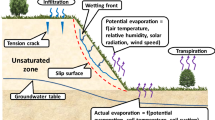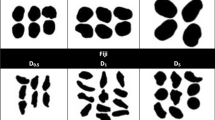Abstract
Laboratory tests were performed on Toyoura sand specimens to investigate the relationship between degree of saturation S r, B-value and P-wave velocity V p. Different types of pore water (de-aired water or tap water) and pore gas (air or CO2) as well as different magnitudes of back pressure were used to achieve different S r (or B-value). The measured relationship between B-value and V p was not consistent with the theoretical prediction. The measurement shows that the V p value in the specimen flushed with de-aired water is independent of B-value (or S r) and is always around the one in fully saturated condition. However, the V p value in the specimen flushed with tap water increases with B-value, but the shape of the relationship between V p and B-value is quite different from the theoretical prediction. The possible explanation for the discrepancy between laboratory measurement and theoretical prediction lies in that the air exists in the water as air bubbles and therefore the pore fluid (air-water mixture) is heterogeneous instead of homogenous assumed in the theoretical prediction.
Similar content being viewed by others
References
ISHIHARA K, TSUCHIYA H, HUANG Y, KAMADA K. Recent studies on liquefaction resistance of sand-effect of saturation [C]// Proceedings of Fourth International Conference on Recent Advances in Geotechnical Earthquake Engineering and Soil Dynamics. San Diego, California: CD-ROM, 2001:1–7.
TSUKAMOTO Y, ISHIHARA K, NAKAZAWA H, HUANG Y. Resistance of partly saturated sand to liquefaction with reference to longitudinal and shear wave velocities [J]. Soils and Foundations, 2002, 42(6):93–104.
YANG J. Liquefaction resistance of sand in relation to P-wave velocity [J]. Géotechnique, 2002, 52(4):295–298.
SKEMPTON A W. The pore-pressure coefficients A and B [J]. Géotechnique, 1954, 4(4):143–147.
YANG J. Pore pressure coefficient for soil and rock and its relation to compressional wave velocity [J]. Géotechnique, 2005, 55(3):251–256.
LEE S H, CHOO Y W, YOUN J U, KIM D S. Determination of P, S-wave velocities and pore water pressure buildup with B-value for nearly saturated sands [J]. Journal of the Korean Geotechnical Society, 2007, 23(2):71–84.
NAESGAARD E, BRYNE P M, WIJEWICKREME D. Is P-wave velocity an indicator of saturation in sand with viscous pore fluid? [J]. International Journal of Geomechanics, 2007, 7(6):437–443.
TAMURA S, TOKIMATSU K, ABE A, SATO M. Effect of air bubble on B-value and P-wave velocity of a partially saturated sand [J]. Soils and Foundations, 2002, 42(1):121–129.
NAKAZAWA H, ISHIHARA K, TSUKAMOTO Y, TOSHIYUKI K. Investigation of in-site elastic wave velocity for assessment of liquefaction [J]. Symposium C of JGS, 2007, 62(2):346–359. (in Japanese)
HAKANATA M, MASUDA T. Experimental study on the relationship between degree of saturation and P-wave velocity in sandy soils [C]// Geotechnical Engineering for Disaster Mitigation and Rehabilitation, Part 4. Beijing: Science Press, 2008:346–351.
LEE J S, SANTAMARINA J C. Bender element, performance and signal interpretation [J]. Journal of Geotechnical and Geoenvironmental Engineering, 2005, 131(9):1063–1070.
LINGS M L, GREENING P D. A novel bender/extender element for soil testing [J]. Géotechnique, 2001, 51(8):713–717.
VIGGIANI G, ATKINSON J H. Interpretation of bender element tests [J]. Géotechnique, 1995, 45(1):149–154.
WANG Y H, LO K F, YAN W M, DONG X B. Measurement biases in the bender element test [J]. Journal of Geotechnical and Geoenvironmental Engineering, 2007, 133(5):564–574.
BIOT M A. Theory of propagation of elastic waves in a fluid-saturated porous solid. I. Low frequency range. II. Higher frequency range [J]. Journal of the Acoustic Society of America, 1956, 28(2):168–191.
NAKAGAWA K, SOGA K, MITCHELL J K. Observation of Biot compressional wave of the second kind in granular soils [J]. Géotechnique, 1997, 47(1):133–147.
GU Xiao-qiang. Dynamic properties of granular materials at the macro and micro scales [D]. Hong Kong: The University of Hong Kong, 2012.
Author information
Authors and Affiliations
Corresponding author
Additional information
Foundation item: Project(2012CB719803) supported by the National Basic Research Program of China; Project(201011159098) supported by the Seed Funding for Basic Research Scheme from The University of Hong Kong, China
Rights and permissions
About this article
Cite this article
Gu, Xq., Yang, J. & Huang, Ms. Laboratory investigation on relationship between degree of saturation, B-value and P-wave velocity. J. Cent. South Univ. 20, 2001–2007 (2013). https://doi.org/10.1007/s11771-013-1701-x
Received:
Accepted:
Published:
Issue Date:
DOI: https://doi.org/10.1007/s11771-013-1701-x




